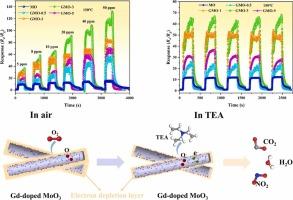Highly responsive detection of triethylamine gas based on Gd-doped MoO3 nanorod sensors: an experimental and first-principles study
IF 3.7
1区 化学
Q1 CHEMISTRY, ANALYTICAL
引用次数: 0
Abstract
Triethylamine (TEA) is widely used in industrial production, but it poses a threat to human health. Therefore, it is crucial to develop highly sensitive sensors for TEA. In this paper, Gd-doped MoO3 nanorod structures with different molar ratios were prepared via a step hydrothermal route by taking advantage of the excellent properties of rare earth elements. After comprehensively characterize, it was confirmed that Gd was successfully doped into the MoO3 lattice. The sensor based on 3 mol% Gd-doped MoO3 exhibited a larger specific surface area and a higher amount of surface-adsorbed oxygen compared to sensors with other doping ratios. The sensor with this optimal doping ratio has a gas sensing response of about 65.8 for 10 ppm TEA at 150 ℃, which is six times higher than that of the pure MoO3 nanorods, with a response time of only 16 s. In addition, the sensor exhibits excellent selectivity, good reproducibility, and excellent long-term stability. Finally, density-functional theory (DFT) calculations indicate that the gadolinium-doped MoO3 material significantly improved the sensing performance for TEA. This study provides a valuable reference for the development of metal-semiconductor (MOS) sensors for the detection of TEA.

基于钆掺杂MoO3纳米棒传感器的高响应检测三乙胺气体:实验和第一性原理研究
三乙胺(TEA)广泛应用于工业生产,但对人体健康构成威胁。因此,开发高灵敏度的TEA传感器至关重要。本文利用稀土元素的优异性质,采用步进水热法制备了不同摩尔比的掺杂钆的MoO3纳米棒结构。经过综合表征,证实Gd成功掺杂到MoO3晶格中。与其他掺杂比例的传感器相比,基于3mol % gd掺杂的MoO3传感器具有更大的比表面积和更高的表面吸附氧量。在150℃条件下,在10 ppm TEA条件下,该传感器的气敏响应约为65.8,是纯MoO3纳米棒的6倍,响应时间仅为16 s。此外,该传感器具有优良的选择性、良好的再现性和优良的长期稳定性。最后,密度泛函理论(DFT)计算表明,掺钆MoO3材料显著提高了TEA的传感性能。该研究为金属半导体(MOS)传感器的发展提供了有价值的参考。
本文章由计算机程序翻译,如有差异,请以英文原文为准。
求助全文
约1分钟内获得全文
求助全文
来源期刊

Sensors and Actuators B: Chemical
工程技术-电化学
CiteScore
14.60
自引率
11.90%
发文量
1776
审稿时长
3.2 months
期刊介绍:
Sensors & Actuators, B: Chemical is an international journal focused on the research and development of chemical transducers. It covers chemical sensors and biosensors, chemical actuators, and analytical microsystems. The journal is interdisciplinary, aiming to publish original works showcasing substantial advancements beyond the current state of the art in these fields, with practical applicability to solving meaningful analytical problems. Review articles are accepted by invitation from an Editor of the journal.
 求助内容:
求助内容: 应助结果提醒方式:
应助结果提醒方式:


